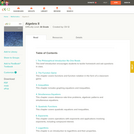
Algebra II provides an introduction to Advanced Algebra topics.
- Subject:
- Algebra
- Mathematics
- Material Type:
- Textbook
- Provider:
- CK-12 Foundation
- Provider Set:
- CK-12 FlexBook
- Date Added:
- 06/20/2013
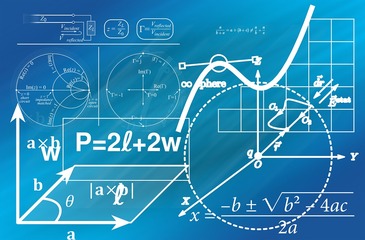

Algebra II provides an introduction to Advanced Algebra topics.

Published in 1991 by Wellesley-Cambridge Press, the book is a useful resource for educators and self-learners alike. It is well organized, covers single variable and multivariable calculus in depth, and is rich with applications.
In addition to the Textbook, there is also an online Instructor's Manual and a student Study Guide. Prof. Strang has also developed a related series of videos, Highlights of Calculus, on the basic ideas of calculus.
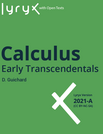
Calculus: Early Transcendentals, originally by D. Guichard, has been redesigned by the Lyryx editorial team. Substantial portions of the content, examples, and diagrams have been redeveloped, with additional contributions provided by experienced and practicing instructors. This approachable text provides a comprehensive understanding of the necessary techniques and concepts of the typical Calculus course sequence, and is suitable for the standard Calculus I, II and III courses.
To practice and develop an understanding of topics, this text offers a range of problems, from routine to challenging, with selected solutions. As this is an open text, instructors and students are encouraged to interact with the textbook through annotating, revising, and reusing to your advantage. Suggestions for contributions to this growing textbook are welcome.
Lyryx develops and supports open texts, with editorial services to adapt the text for each particular course. In addition, Lyryx provides content-specific formative online assessment, a wide variety of supplements, and in-house support available 7 days/week for both students and instructors.
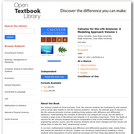
Our writing is based on three premises. First, life sciences students are motivated by and respond well to actual data related to real life sciences problems. Second, the ultimate goal of calculus in the life sciences primarily involves modeling living systems with difference and differential equations. Understanding the concepts of derivative and integral are crucial, but the ability to compute a large array of derivatives and integrals is of secondary importance. Third, the depth of calculus for life sciences students should be comparable to that of the traditional physics and engineering calculus course; else life sciences students will be short changed and their faculty will advise them to take the 'best' (engineering) course.

College Algebra is an introductory text for a college algebra survey course. The material is presented at a level intended to prepare students for Calculus while also giving them relevant mathematical skills that can be used in other classes. The authors describe their approach as "Functions First," believing introducing functions first will help students understand new concepts more completely. Each section includes homework exercises, and the answers to most computational questions are included in the text (discussion questions are open-ended).
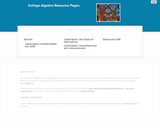
This course covers relations and functions, specifically, linear, polynomial, exponential, logarithmic, and rational functions. Additionally, sections on conics, systems of equations and matrices and sequences are also available.
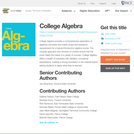
College Algebra provides a comprehensive exploration of algebraic principles and meets scope and sequence requirements for a typical introductory algebra course. The modular approach and richness of content ensure that the book meets the needs of a variety of courses. College Algebra offers a wealth of examples with detailed, conceptual explanations, building a strong foundation in the material before asking students to apply what they've learned.
Note: this resource now links to the second edition, released in 2021. This record is in maintained in OER Commons to allow users to see endorsements, reviews, etc... for the 1st edition.
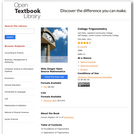
This book was designed as an introductory trigonometry textbook for college students with the explicit goal of reducing textbook costs.
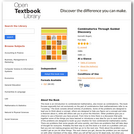
his book is an introduction to combinatorial mathematics, also known as combinatorics. The book focuses especially but not exclusively on the part of combinatorics that mathematicians refer to as “counting.” The book consists almost entirely of problems. Some of the problems are designed to lead you to think about a concept, others are designed to help you figure out a concept and state a theorem about it, while still others ask you to prove the theorem. Other problems give you a chance to use a theorem you have proved. From time to time there is a discussion that pulls together some of the things you have learned or introduces a new idea for you to work with. Many of the problems are designed to build up your intuition for how combinatorial mathematics works. There are problems that some people will solve quickly, and there are problems that will take days of thought for everyone. Probably the best way to use this book is to work on a problem until you feel you are not making progress and then go on to the next one. Think about the problem you couldn’t get as you do other things. The next chance you get, discuss the problem you are stymied on with other members of the class. Often you will all feel you’ve hit dead ends, but when you begin comparing notes and listening carefully to each other, you will see more than one approach to the problem and be able to make some progress. In fact, after comparing notes you may realize that there is more than one way to interpret the problem. In this case your first step should be to think together about what the problem is actually asking you to do. You may have learned in school that for every problem you are given, there is a method that has already been taught to you, and you are supposed to figure out which method applies and apply it. That is not the case here. Based on some simplified examples, you will discover the method for yourself. Later on, you may recognize a pattern that suggests you should try to use this method again.

All of the mathematics required beyond basic calculus is developed “from scratch.” Moreover, the book generally alternates between “theory” and “applications”: one or two chapters on a particular set of purely mathematical concepts are followed by one or two chapters on algorithms and applications; the mathematics provides the theoretical underpinnings for the applications, while the applications both motivate and illustrate the mathematics. Of course, this dichotomy between theory and applications is not perfectly maintained: the chapters that focus mainly on applications include the development of some of the mathematics that is specific to a particular application, and very occasionally, some of the chapters that focus mainly on mathematics include a discussion of related algorithmic ideas as well.
The mathematical material covered includes the basics of number theory (including unique factorization, congruences, the distribution of primes, and quadratic reciprocity) and of abstract algebra (including groups, rings, fields, and vector spaces). It also includes an introduction to discrete probability theory—this material is needed to properly treat the topics of probabilistic algorithms and cryptographic applications. The treatment of all these topics is more or less standard, except that the text only deals with commutative structures (i.e., abelian groups and commutative rings with unity) — this is all that is really needed for the purposes of this text, and the theory of these structures is much simpler and more transparent than that of more general, non-commutative structures.

This is a free textbook which covers material for an introductory course on differential equations with some partial differential equations material, though it assumes knowledge of matrix theory. It includes a section on computing Fourier series of polynomials. It also includes a link to the freely available student solutions manual.
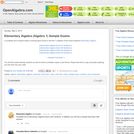
Complete set of mobile friendly Elementary Algebra sample exams with solutions. In addition, there are links to pdf versions and a sample final exam with answers.
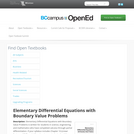
Elementary Differential Equations with Boundary Value Problems is written for students in science, engineering, and mathematics who have completed calculus through partial differentiation. If your syllabus includes Chapter 10 (Linear Systems of Differential Equations), your students should have some preparation in linear algebra. In writing this book I have been guided by the these principles: An elementary text should be written so the student can read it with comprehension without too much pain. I have tried to put myself in the student's place, and have chosen to err on the side of too much detail rather than not enough. An elementary text can't be better than its exercises. This text includes 2041 numbered exercises, many with several parts. They range in difficulty from routine to very challenging. An elementary text should be written in an informal but mathematically accurate way, illustrated by appropriate graphics. I have tried to formulate mathematical concepts succinctly in language that students can understand. I have minimized the number of explicitly stated theorems and defonitions, preferring to deal with concepts in a more conversational way, copiously illustrated by 299 completely worked out examples. Where appropriate, concepts and results are depicted in 188 figures

Elements of Abstract and Linear Algebra is a book written by Dr. Edwin Connell, a professor emeritus in the math department at the University of Miami. Published in December 2001, it can be obtained free of charge from this Web site. Dr. Connell even encourages printing and distributing the book as an inexpensive resource for college students. The text is divided into sections that can be downloaded separately or as a whole. There are many theorems, proofs, and exercises throughout the book that illustrate the underlying concepts. The book is offered in four formats; so, most computers should be able to view it with no problems.
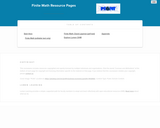
Mathematics
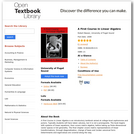
A First Course in Linear Algebra is an introductory textbook aimed at college-level sophomores and juniors. Typically students will have taken calculus, but it is not a prerequisite. The book begins with systems of linear equations, then covers matrix algebra, before taking up finite-dimensional vector spaces in full generality. The final chapter covers matrix representations of linear transformations, through diagonalization, change of basis and Jordan canonical form. Determinants and eigenvalues are covered along the way.
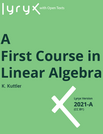
This text, originally by K. Kuttler, has been redesigned by the Lyryx editorial team as a first course in linear algebra for science and engineering students who have an understanding of basic algebra.
All major topics of linear algebra are available in detail, as well as proofs of important theorems. In addition, connections to topics covered in advanced courses are introduced. The text is designed in a modular fashion to maximize flexibility and facilitate adaptation to a given course outline and student profile.
Each chapter begins with a list of student learning outcomes, and examples and diagrams are given throughout the text to reinforce ideas and provide guidance on how to approach various problems. Suggested exercises are included at the end of each section, with selected answers at the end of the text.
Lyryx develops and supports open texts, with editorial services to adapt the text for each particular course. In addition, Lyryx provides content-specific formative online assessment, a wide variety of supplements, and in-house support available 7 days/week for both students and instructors.
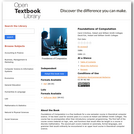
Foundations of Computation is a free textbook for a one-semester course in theoretical computer science. It has been used for several years in a course at Hobart and William Smith Colleges. The course has no prerequisites other than introductory computer programming. The first half of the course covers material on logic, sets, and functions that would often be taught in a course in discrete mathematics. The second part covers material on automata, formal languages, and grammar that would ordinarily be encountered in an upper level course in theoretical computer science.
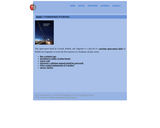
This open-source book by Crowell, Robbin, and Angenent is a spin-off of a previous open-source book by Robbin and Angenent. It covers the first semester of a freshman calculus course.
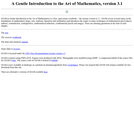
This book is designed for the transition course between calculus and differential equations and the upper division mathematics courses with an emphasis on proof and abstraction. The book has been used by the author and several other faculty at Southern Connecticut State University. There are nine chapters and more than enough material for a semester course. Student reviews are favorable.
It is written in an informal, conversational style with a large number of interesting examples and exercises, so that a student learns to write proofs while working on engaging problems.